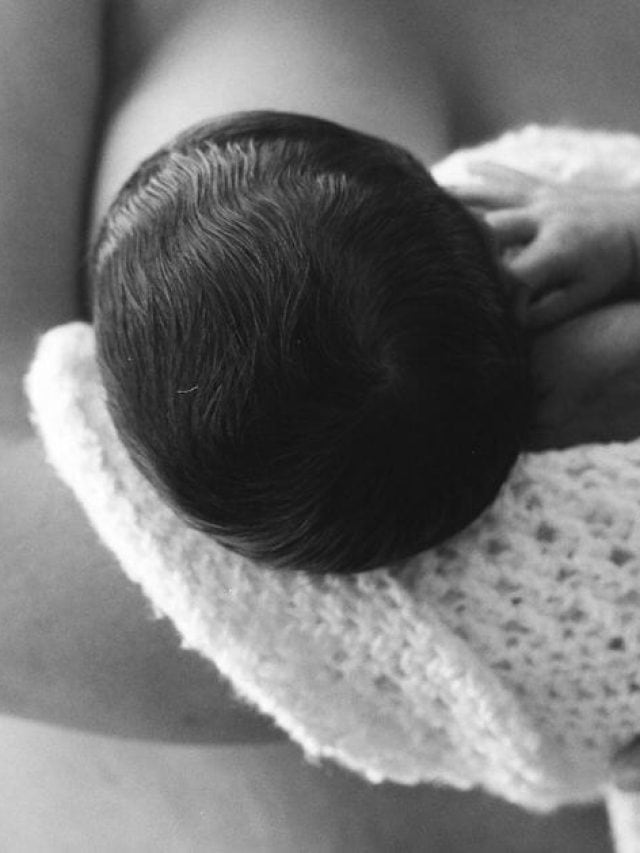There is something so comforting about holding a newborn baby. Their scent, their softness, their tiny, delicate features… Taking in their whole being when you’re skin to skin is such a pleasure.
What if I told you that the mere act of holding your naked baby to your chest after birth can yield immense benefits for you both?
Skin to skin contact is more widely discussed (and researched!) in the parenting community than ever before. This is particularly because it has such wonderful benefits for both parents.
Instead of allowing healthy newborns to be whisked away to the nursery after birth, more parents than ever are interested in pursuing the joy that comes from immediate skin contact.

This site contains affiliate links, meaning that we earn a small commission for purchases made through our site. We only recommend products we personally use, love, or have thoroughly vetted.
Discovering the Importance of Holding My Baby After Birth
When I started writing a birth plan before our first child was born, I was bewildered by the number of decisions I would have to make for her so soon after birth.
Aside from questions about whether my husband would cut her umbilical cord and if I planned to breastfeed, I was struck by a section on skin to skin contact.
I was confused – didn’t every new mom want to hold their baby after birth?
After a short Google search, I quickly learned that skin to skin is not just a matter of snuggling your baby. It’s a crucial part of the postpartum process.
I simply didn’t understand the benefits of skin contact. I was also unaware that many nurses tend to interfere with the process of skin to skin contact.
To be fair, they often do so in order to complete various clinical procedures, such as checking the baby’s weight and other stats.
But if this practice is something that’s important to you, it’s vital to educate yourself on the benefits of the experience.
You’ll also want to understand the guidelines for how you should engage in skin to skin contact with your new baby.
The Skin to Skin Benefits You Should Know About
Placing your freshly birthed baby onto your chest seems like a natural reaction.
Sure, it would also seem apparent that there are obvious skin to skin benefits. But the true reasons why skin contact is so essential might surprise you.
You might assume that holding your baby close after delivery is merely to comfort them, love them, and safely welcome them into their big, new world.
There are, however, more scientific advantages for mother and baby that will make ensuring skin to skin takes place exponentially more important.
According to Sanford Health, there are very particular benefits of skin to skin contact for baby and mother:
Benefits for Baby
- Improved weight gain after birth
- Enhanced body temperature control
- Better breathing and heartbeat stabilization
- Stronger immune systems
- Less crying
- Better digestion of nutrients
- Higher chance of a successful breastfeeding experience
- Improved brain function and parental attachment in the long-term

Benefits for Mother
- Increased breastmilk supply
- Decreased postpartum bleeding
- Improved breastfeeding experience overall
- Lowered chance of developing postpartum depression and anxiety
Is Contact With Dad Just As Important?
During discussions about postpartum care, the conversation typically revolves around mom and baby.
It’s critical to understand that dads can play a crucial role in the skin to skin benefits for babies, just as easily as moms can.
After our first daughter was born, my husband and I focused primarily on my time spent practicing skin to skin contact with her.
It wasn’t that he lacked an interest in the process or that I was greedy (although, now that I think about it, maybe I was a little bit!).
It was more the fact that we assumed the benefits of skin to skin came primarily from me practicing it.
But when we were pregnant with our second daughter, we learned more about the benefits of the process. We finally understood that dads can be just as vital in providing the previously mentioned advantages to babies.
Not only that, but skin contact with dad also allows fathers to bond with their newborns more closely. It also helps dads to become more connected to their new role as a parent.
So moms, after your little one has made their big debut, don’t be afraid to catch a few minutes of rest while you let dad take the skin to skin reigns.

The “Right” Way to Do Skin to Skin
According to an article from the CDC on Maternity Care Practices, “nearly all infants are born in a hospital. Their stay is typically very short, but events during this time have lasting effects.”
One of the “events” referenced in this article is skin to skin contact.
It’s worth noting that there’s actually a “right” way to practice skin to skin contact.
The CDC, for example, uses the following skin to skin guidelines to explain the best way of reaping the most benefits of this practice:
- Babies should be placed directly onto a mother’s chest following their birth.
- There should be no bedding or clothing between mother and baby during this practice. A warm blanket, however, should be placed over top of them.
- To gain the most physiological benefits of skin-to-skin, babies should remain on their mother’s chest for at least an hour or until after their first nursing session.
It’s worth noting that for your baby to gain many of the benefits of skin to skin, anyone can practice it with them in that first hour after birth. That’s where that skin contact with dad comes in!
If you’re planning on breastfeeding, though, you need to have this time with your baby to successfully jumpstart your nursing experience.
And don’t be afraid to continue practicing skin to skin throughout the early weeks of your baby’s life. It’s been shown that the experience is still beneficial after you leave the hospital!
Skin to Skin Care FAQ
Guidelines for a successful skin to skin experience might seem cut-and-dry, but this doesn’t mean questions won’t arise for you.
Whether you’re concerned about how to practice skin to skin after a c-section, or you’re wondering how to make skin to skin work with multiples, we’re here to help!
1. Can You Practice It if You Have a C-Section?
In years past, the likelihood of being allowed to practice skin to skin after a cesarean birth was slim. Vaginal birth seemed to be the easiest way to place baby on the mother’s body.
Today, however, many hospitals are now making allowances for mothers to still enjoy that “golden hour” after delivery to make sure that baby experiences the benefits of skin contact.
If this is something you’re interested in, make sure to let your care team know upfront, or put it into your birth plan.
Wondering what the heck a birth plan is, or how to write a birth plan? We’ve got you covered there, too!
In facilities that don’t allow this practice, it’s worth asking about their policies regarding skin contact with dad after birth.
2. Can You Practice Skin to Skin with Premature Babies?
Full term babies aren’t the only ones who can benefit from skin to skin time.
Not only can you enjoy skin to skin bonding with premature babies, but it’s also very encouraged. Some of the benefits, including heartbeat and temperature regulation, are even more important in preterm babies.
It’s crucial to speak with your child’s medical caregivers to determine whether your premie is ready to be held or not.
If it’s not yet safe to do skin to skin, you can try a hand hug, which involves gently laying one hand on the baby’s head and the other on their tummy or feet.
This comforting sensation is a great advantage to NICU babies.
3. How Can I Practice This With Twins?!
Absolutely! You’ll just need to lay one baby onto each individual breast.
While finding the right position can seem awkward, this is the perfect chance for your partner to jump into the situation and help.
Some studies have even shown that each breast is biologically capable of adjusting its unique temperature to meet each baby’s individual needs.
4. Is it Safe?
Generally speaking, there’s nothing dangerous about practicing skin-to-skin with your baby. That being said, you should exercise caution while doing it.
Here are a few helpful tips for a safe skin to skin experience:
- Make sure baby’s face can be seen and that their head is in a “sniffing” position
- Check to sure baby’s nose and mouth are not covered
- Look to see that baby’s head is turned to one side and that their neck is straight, not bent
- Make sure that baby’s shoulders and chest face you and that their legs are flexed
- When the person performing skin to skin is tired and needs to sleep, make sure the baby is safely placed in a bassinet or with another support person.
- Never practice skin to skin while you are asleep, or when you might fall asleep.
The Easy Decision to Practice Skin to Skin Bonding with Your Baby
Some postpartum decisions are hard to make.
Choosing between formula and breastfeeding or cloth diapers or disposable, for instance, take careful consideration.
When it comes to skin contact, the choice seems rather easy, though.
If spending some extra time with your little one cuddled safely on your chest can present both mental and physical benefits for mom and baby, why not give it a try?
Just remember to voice your preferences and advocate for your medical choices during your hospital stay. This will help to ensure you receive the opportunities for skin contact with your baby that you deserve.
Which benefits of skin to skin contact are you most excited about? Tell us all about it in the comments!










